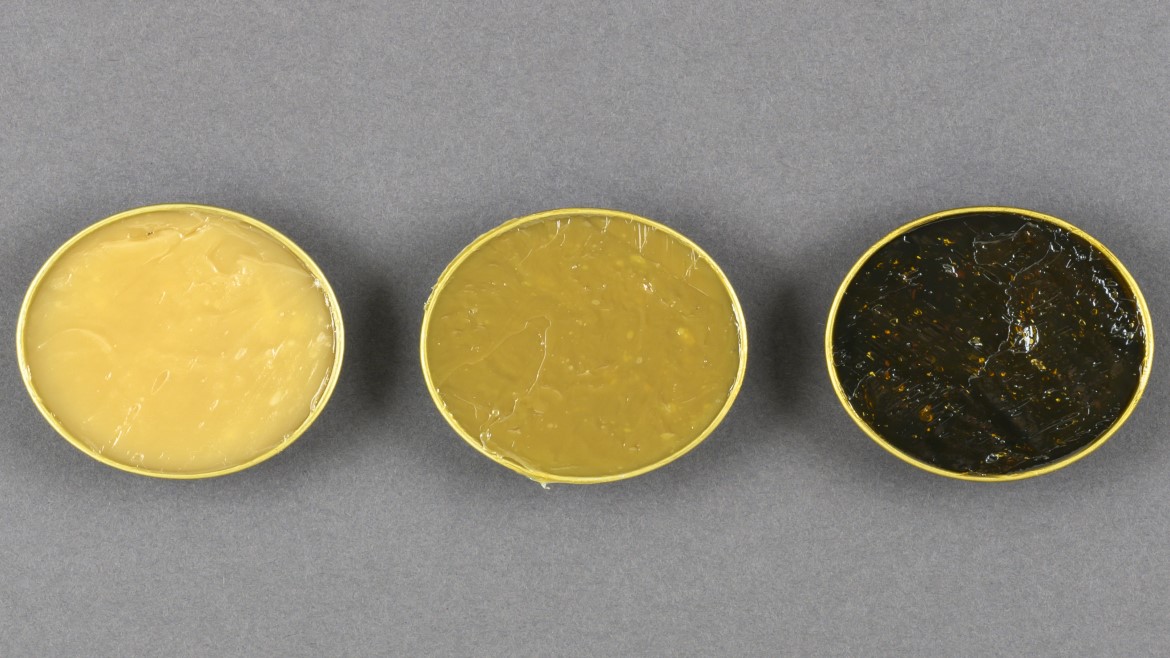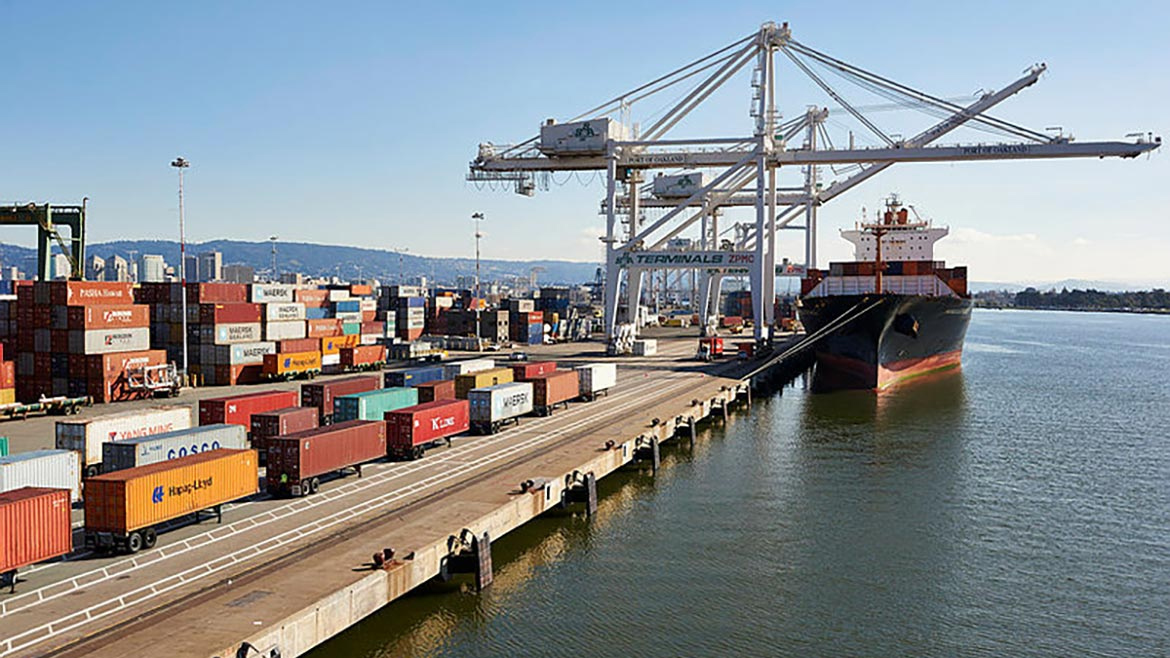Aug 11, 2020
Posted by Tim Smith, Technology Manager
Businesses are becoming increasingly aware of the importance of environmentally sustainable practices, not just to their own operations, but also to society and communities. Many view sustainability as a vital component of future growth—key for remaining competitive in a rapidly evolving global economy. As countries struggle against the devastating impact of the COVID-19 pandemic, politicians, investors and campaigners are seizing the opportunity to push sustainability to the forefront of recovery plans. A likely outcome is low carbon investments in infrastructure and accelerated transition to clean energy. As these investments become increasingly oriented towards environmentally agreeable projects, the carbon footprint will become one of many sustainability metrics that suppliers and contractors will be measured against. For those operating hydraulic equipment, the energy demand, whether from diesel or electricity, is a well-known and significant contributor to emissions. Increasing hydraulic energy efficiency is an achievable route to reducing energy use and maintaining competitiveness in a low carbon economy.
Solutions that improve efficiency should be low risk, cost effective and not require significant downtime for implementation; therefore, a particularly clever efficiency upgrade is the use of an energy-efficient hydraulic fluid. These fluids have been on the market for some time, but operators, original equipment manufacturers (OEMs) and buyers remain cautious due to limited scientific evidence of their efficiency and uncertainty around the real benefits they might see. Recognizing the need for more insight in this area, we undertook a multi-year research project to study current and future energy-efficient hydraulic fluids. Mixed results observed in the testing of conventional fluids motivated a more in-depth look at precisely how a fluid can influence and improve hydraulic efficiency.
Consideration of mechanical efficiency and volumetric efficiency is useful for establishing potential impact on a hydraulic pump but overlooks the remainder of the hydraulic system. Arguably, the hydraulic pump is only a small part of a much larger network of pipes, valves, filters, heat exchangers, actuators and motors. All the while, the fluid, which is responsible for the transfer of power, must transit all these components whilst transmitting as much pressure as possible. It is therefore not surprising that the greatest energy loss in a hydraulic system has been attributed to the pipes [D. A. Green, World Tribology Congress 2009, Japan, B2-212].
Tackling the areas of largest energy loss in hydraulics allows for a greater overall improvement in efficiency. As most energy loss is due to the transit of the fluid, studying fluid flow characteristics becomes an enticing area of research that has been surprisingly overlooked by the industry. We have used computer simulations, corroborated with laboratory measurements, to accurately study the passage of fluid through various changes in geometry. Measuring flow in pipes with simple flow meters or differential pressure transducers provides some useful information; more sophisticated techniques were required to elucidate the important subtleties in fluid flow characteristics. Particle image velocimetry is a well-established technique that we have employed to visualize and quantify fluid flow. The hydraulic fluid is seeded with microscopic particles, and under laser illumination, the particle motion can be captured with high speed cameras.
This allows visualization and quantification of undesirable flow behaviors. For instance, a fluid approaching a pipe bend has coherent and largely non-mixing streamlines that comprise the primary flow path. The fastest moving fluid is in the center of the channel, whilst slower-moving fluid hugs the pipe walls.
As this fluid transits the bend, a secondary flow emerges with a vortex-like motion that mixes the streamlines (Figure 1). The fast-moving fluid is then combined with the slow-moving fluid causing a loss in momentum. This results in a pressure drop across the pipe bend leading to reduced hydraulic power.

Figure 1: An illustration of fluid flow and the energy depleting mixing motion induced in pipe bends.
As wasted energy typically manifests itself as heat, it is unsurprising that in addition to flow improvements a reduction in operating temperature is also observed (Figure 2). Sump temperatures can be lowered by up to 5 °C, which has practical benefits on fluid life and durability by limiting thermal stress. A reduced burden on energy intensive cooling systems further contributes to total system efficiency.
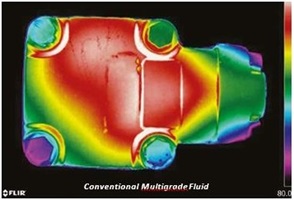
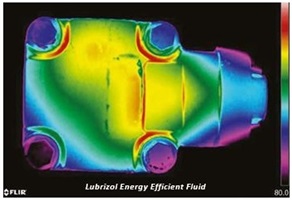
Figure 2: Thermal images of an Eaton Vickers® 20VQ vane pump. The hottest surface temperatures are indicated in red and reached 95 °C. Cooler temperatures were observed with our energy-efficient hydraulic fluid.
In addition to its unique energy-saving features, this new hydraulic fluid was carefully formulated to exceed the requirements of main-line hydraulic pump OEM specifications.
Retention of performance is assured by its exceptional shear stability. Unlike many conventional hydraulic fluids on the market, the energy-efficient fluid does not shear out-of-grade after industry standard shear testing. The robust additive technology extends fluid life, potentially leading to longer drain intervals.
Tightly controlled field trials were conducted to accurately compare our energy-efficient hydraulic fluid against conventional multi-grade and mono-grade examples. In all cases, the formulations consisted of API Group II base oils, an anti-wear hydraulic fluid additive and a pour point depressant.
The comparative multi-grade fluid contained a poly(alkyl methacrylate) [PMA] viscosity modifier making it highly representative of many readily available multi-grade fluids. Crucially, and in contrast to several other studies, all the formulations were ISO viscosity grade 46 and met industry requirements for OEM hydraulic fluid specifications Parker Denison HF-0 and Eaton Brochure E-FDGN-TB002-E.
The real-world relevance of the field trials was ensured by comparing all fluids at equal viscosity and testing in equipment designed and specified for this ISO viscosity grade. Extensive instrumentation of a range of mobile equipment allowed a big-data approach where millions of sensor readings were recorded and analysed in well-defined duty cycles. Some specific flow and pressure conditions in the hydraulic system showed double digit efficiency improvements for energy-efficient fluid. These, however, were barely relevant to any particular duty cycle so were discarded in favor of those showing a recurring demand on the machine.
In these relevant duty cycles, both the monograde and multi-grade comparative fluids showed similar performance but were easily outperformed by our energy-efficient fluid.
With this fluid, a backhoe loader exhibited a 3 – 6% fuel efficiency improvement (Figure 3) depending on the duty cycle, whilst a wheel loader with fewer duty cycles showed 2.7% efficiency improvement. This advantage is not limited to mobile equipment, as exemplified by a further field trial in a large plastic injection molding machine operated over an extended period.
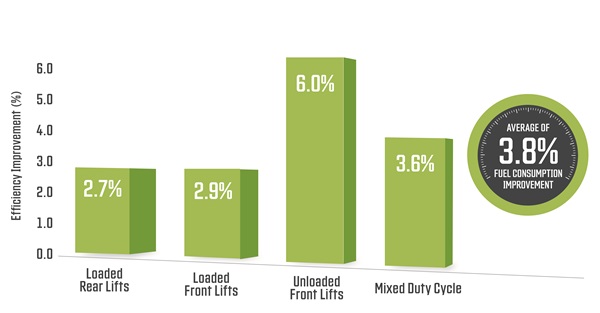
Figure 3: Graph showing the fuel efficiency improvement results of a backhoe loader operating a number of duty cycles when comparing the use of our energy-efficient hydraulic fluid against a conventional multi-grade hydraulic fluid.
Compared to an ISO VG 46 mono-grade fluid, the corresponding ISO VG 46 energy-efficient fluid reduced electricity consumption of the hydraulic system by 8.5% (Figure 4).

Figure 4: Graph showing the reduced hydraulic power consumption (kW) of a plastic injection molding machine when comparing the use of our energy-efficient hydraulic fluid against a conventional mono-grade hydraulic fluid.
Our View
Fixed hydraulic equipment, often housed in temperature-controlled environments, does not require low temperature fluidity that is provided by high viscosity index multi-grade fluids.
There is, however, a clear need for reduced energy consumption on production lines, twinned with the exacting requirements for durability and reduced down-time. Thus, the benefits can be enjoyed by all hydraulic users, where energy savings entirely offset the cost of upgrading in less than two months of operation.
There is no better time to start demonstrating commitment to environmental sustainability, whilst simultaneously increasing productivity and profitability.



